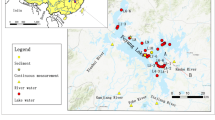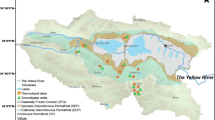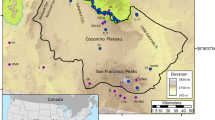Abstract
On the Qinghai-Tibet Plateau, permafrost degradation and associated release of permafrost meltwater has undoubtedly modified the annual and seasonal streamflow patterns and influenced groundwater conditions. However, it is still unclear how extensively permafrost degradation has influenced surface and subsurface water systems due to very sparse observations. Isotope mass models combining tritium and 222Rn measurements are developed here to quantify the contributions of groundwater discharge and thawing permafrost to rivers and lakes in the Source Area of the Yellow River. Results demonstrate the spatial variability of permafrost thaw impacts and confirm significant influence on surface and subsurface runoff processes including effects on water yield capacity and water drainage connectivity. While results to date are conclusive, further work to refine the method and extend observations is warranted.







Similar content being viewed by others
References
Walvoord MA, Kurylyk BL (2016) Hydrologic impacts of thawing permafrost—a review. Vadose Zone J. https://doi.org/10.2136/vzj2016.01.0010
Li X, Cheng G, Jin H, Kang E, Che T, Jin R, Wu L, Nan Z, Wang J, Shen Y (2008) Cryospheric change in China. Glob Planet Change 62(3–4):210–218. https://doi.org/10.1016/j.gloplacha.2008.02.001
Ran Y, Li X, Cheng G (2017) Climate warming has led to the degradation of permafrost stability in the past half century over the Qinghai-Tibet Plateau. In: The Cryosphere Discussions, pp 1–30. https://doi.org/10.5194/tc-2017-120
Connon RF, Quinton WL, Craig JR, Hayashi M (2014) Changing hydrologic connectivity due to permafrost thaw in the lower Liard River valley, NWT, Canada. Hydrol Process 28(14):4163–4178. https://doi.org/10.1002/hyp.10206
Walvoord MA, Voss CI, Wellman TP (2012) Influence of permafrost distribution on groundwater flow in the context of climate-driven permafrost thaw: example from Yukon Flats Basin, Alaska, United States. Water Resour Res 48(7):1–17. https://doi.org/10.1029/2011WR011595
Cheng G, Jin H (2013) Permafrost and groundwater on the Qinghai-Tibet Plateau and in northeast China. Hydrogeol J 21(1):5–23. https://doi.org/10.1007/s10040-012-0927-2
Ala-Aho P, Soulsby C, Pokrovsky OS, Kirpotin SN, Karlsson J, Serikova S, Vorobyev SN, Manasypov RM, Loiko S, Tetzlaff D (2018) Using stable isotopes to assess surface water source dynamics and hydrological connectivity in a high-latitude wetland and permafrost influenced landscape. J Hydrol 556:279–293. https://doi.org/10.1016/j.jhydrol.2017.11.024
Brutsaert W, Hiyama T (2012) The determination of permafrost thawing trends from long-term streamflow measurements with an application in eastern Siberia. J Geophys Res Atmos 117(22):1–10. https://doi.org/10.1029/2012JD018344
St. Jacques JM, Sauchyn DJ (2009) Increasing winter baseflow and mean annual stream flow from possible permafrost thawing in the Northwest Territories, Canada. Geophys Res Lett 36(1):L01401. https://doi.org/10.1029/2008gl035822
Walvoord MA, Striegl RF (2007) Increased groundwater to stream discharge from permafrost thawing in the Yukon River Basin: potential impacts on lateral export of carbon and nitrogen. Geophys Res Lett 34(12):L12402. https://doi.org/10.1029/2007GL030216
Smith LC, Pavelsky TM, MacDonald GM, Shiklomanov AI, Lammers RB (2007) Rising minimum daily flows in northern Eurasian rivers: a growing influence of groundwater in the high-latitude hydrologic cycle. J Geophys Res. https://doi.org/10.1029/2006JG000327
Streletskiy DA, Tananaev NI, Opel T, Shiklomanov NI, Nyland KE, Streletskaya ID, Shiklomanov AI (2015) Permafrost hydrology in changing climatic conditions: seasonal variability of stable isotope composition in rivers in discontinuous permafrost. Environ Res Lett 10(9):95003. https://doi.org/10.1088/1748-9326/10/9/095003
Wu X, Zhang X, Xiang X, Zhang K, Jin H, Chen X, Wang C, Shao Q, Hua W (2018) Changing runoff generation in the source area of the Yellow River: mechanisms, seasonal patterns and trends. Cold Reg Sci Technol 155(June):58–68. https://doi.org/10.1016/j.coldregions.2018.06.014
Ge M, Wang S, Sun Z, Ma R, Hu Y, Chang Q, Xing W (2017) Hydrological connectivity from glaciers to rivers in the Qinghai-Tibet Plateau: roles of suprapermafrost and subpermafrost groundwater. Hydrol Earth Syst Sci 21(9):4803–4823. https://doi.org/10.5194/hess-21-4803-2017
Yang Y, Wu Q, Jin H (2016) Evolutions of water stable isotopes and the contributions of cryosphere to the alpine river on the Tibetan Plateau. Environ Earth Sci 75(1):1–11. https://doi.org/10.1007/s12665-015-4894-5
Yang Y, Wu Q, Yun H, Jin H, Zhang Z (2016) Evaluation of the hydrological contributions of permafrost to the thermokarst lakes on the Qinghai-Tibet Plateau using stable isotopes. Glob Planet Change 140:1–8. https://doi.org/10.1016/j.gloplacha.2016.03.006
Yang Y, Wu Q, Jin H, Wang Q, Huang Y, Luo D, Gao S, Jin X (2019) Delineating the hydrological processes and hydraulic connectivities under permafrost degradation on Northeastern Qinghai-Tibet Plateau, China. J Hydrol 569:359–372. https://doi.org/10.1016/j.jhydrol.2018.11.068
Yi P, Wan C, Jin H, Luo D, Yang Y, Wang Q, Yu Z, Aldahan A (2018) Hydrological insights from hydrogen and oxygen isotopes in Source Area of the Yellow River, east-northern part of Qinghai-Tibet Plateau. J Radioanal Nucl Chem 317(1):131–144. https://doi.org/10.1007/s10967-018-5864-7
Zheng MJ, Wan CW, Du MD, Zhou XD, Yi P, Aldahan A, Jin HJ, Luo DL, Yu ZB, Gong M (2016) Application of Rn-222 isotope for the interaction between surface water and groundwater in the Source Area of the Yellow River. Hydrol Res 47(6):1253–1262. https://doi.org/10.2166/nh.2016.070
Yi P, Luo H, Chen L, Yu Z, Jin H, Chen X, Wan C, Aldahan A, Zheng M, Hu Q (2018) Evaluation of groundwater discharge into surface water by using Radon-222 in the Source Area of the Yellow River, Qinghai-Tibet Plateau. J Environ Radioact 192:257–266. https://doi.org/10.1016/j.jenvrad.2018.07.003
Gao Z, Niu F, Lin Z, Luo J, Yin G, Wang Y (2018) Evaluation of thermokarst lake water balance in the Qinghai-Tibet Plateau via isotope tracers. Sci Total Environ 636:1–11. https://doi.org/10.1016/j.scitotenv.2018.04.103
Gibson JJ, Birks SJ, Yi Y (2016) Stable isotope mass balance of lakes: a contemporary perspective. Quatern Sci Rev 131:316–328. https://doi.org/10.1016/j.quascirev.2015.04.013
Petermann E, Gibson JJ, Knöller K, Pannier T, Weiß H, Schubert M (2018) Determination of groundwater discharge rates and water residence time of groundwater-fed lakes by stable isotopes of water (18O,2H) and radon (222Rn) mass balances. Hydrol Process 32(6):805–816. https://doi.org/10.1002/hyp.11456
Gibson JJ, Birks SJ, Yi Y (2016) Higher tritium concentrations measured in permafrost thaw lakes in northern Alberta. Hydrol Process 30(2):245–249. https://doi.org/10.1002/hyp.10599
Samalavičius V, Mokrik R (2016) Tritium activity trend formation in groundwater of Quaternary aquifer system, south-eastern Lithuania. Geol Geogr. https://doi.org/10.6001/geol-geogr.v2i4.3399
Bond MJ, Carr J (2018) Permafrost thaw and implications for the fate and transport of tritium in the Canadian north. J Environ Radioact 192(March):295–311. https://doi.org/10.1016/j.jenvrad.2018.07.006
Su X, Xu W, Yang F, Zhu P (2015) Using new mass balance methods to estimate gross surface water and groundwater exchange with naturally occurring tracer 222Rn in data poor regions: a case study in northwest China. Hydrol Process 29(6):979–990. https://doi.org/10.1002/hyp.10208
Jin H, He R, Cheng G, Wu Q, Wang S, Lü L, Chang X (2009) Changes in frozen ground in the source area of the yellow river on the qinghai-tibet plateau, China, and their eco-environmental impacts. Environ Res Lett. https://doi.org/10.1088/1748-9326/4/4/045206
Luo D, Jin H, Jin X, He R, Li X, Muskett RR, Marchenko RR, Romanovsky VE (2018) Elevation-dependent thermal regime and dynamics of frozen ground in the Bayan Har Mountains, northeastern Qinghai-Tibet Plateau, southwest China. Permafrost Periglac Process 29(4):257–270. https://doi.org/10.1002/ppp.1988
Li J, Sheng Y, Wu J, Feng Z, Ning Z, Hu X, Zhang X (2016) Landform-related permafrost characteristics in the source area of the Yellow River, eastern Qinghai-Tibet Plateau. Geomorphology 269:104–111. https://doi.org/10.1016/j.geomorph.2016.06.024
Wang S, Sheng Y, Li J, Wu J, Cao W, Ma S (2018) An Estimation of Ground Ice Volumes in Permafrost Layers in Northeastern Qinghai-Tibet Plateau, China. Chin Geogr Sci 28(1):61–73. https://doi.org/10.1007/s11769-018-0932-z
Luo D, Jin H, Wu Q, Bense VF, He R, Ma Q, Gao S, Jin X, Lü L (2018) Thermal regime of warm-dry permafrost in relation to ground surface temperature in the Source Areas of the Yangtze and Yellow rivers on the Qinghai-Tibet Plateau, SW China. Sci Total Environ 618:1033–1045. https://doi.org/10.1016/j.scitotenv.2017.09.083
Wan C, Gibson JJ, Shen S, Yi Y, Yi P, Yu Z (2019) Using stable isotopes paired with tritium analysis to assess thermokarst lake water balances in the Source Area of the Yellow River, northeastern Qinghai-Tibet Plateau. Sci Total Environ, China. https://doi.org/10.1016/j.scitotenv.2019.06.427
Cook PG (2013) Estimating groundwater discharge to rivers from river chemistry surveys. Hydrol Process 27(25):3694–3707. https://doi.org/10.1002/hyp.9493
Ellins KK, Roman-Mas A, Lee R (1990) Using 222Rn to examine groundwater/surface discharge interaction in the Rio Grande de Manati, Puerto Rico. J Hydrol 115(1–4):319–341
Peng TH, Takahashi T, Broecker W (1974) Surface radon measurements in the north Pacific ocean station PAPA. J Geophys Res 79(12):1772–1780
Stellato L, Petrella E, Terrasi F, Belloni P, Belli M, Sansone U, Celico F (2008) Some limitations in using 222Rn to assess river–groundwater interactions: the case of Castel di Sangro alluvial plain (central Italy). Hydrogeol J 16(4):701–712. https://doi.org/10.1007/s10040-007-0263-0
Dimova NT, Burnett WC (2011) Evaluation of groundwater discharge into small lakes based on the temporal distribution of radon-222. Limnol Oceanogr 56(2):486–494
Dimova NT, Burnett WC, Chanton JP, Corbett JE (2013) Application of radon-222 to investigate groundwater discharge into small shallow lakes. J Hydrol 486:112–122
Gilfedder BS, Frei S, Hofmann H, Cartwright I (2015) Groundwater discharge to wetlands driven by storm and flood events: quantification using continuous Radon-222 and electrical conductivity measurements and dynamic mass-balance modelling. Geochim Cosmochim Acta 165:161–177. https://doi.org/10.1016/j.gca.2015.05.037
MacIntyre S, Fram J, Kushner P, O’Brien WJ, Hobbie J, Kling GR, Wanninkhof R, Chanton JP (1995) Trace gas exchange across the air-water interface in freshwater and coastal marine environments. In: Biogenic trace gases: measuring emission from soil and water. Blackwell, pp 52–97
Cartwright I, Morgenstern U (2018) Using tritium and other geochemical tracers to address the “old water paradox” in headwater catchments. J Hydrol 563:13–21. https://doi.org/10.1016/j.jhydrol.2018.05.060
Cartwright I, Morgenstern U (2016) Using tritium to document the mean transit time and sources of water contributing to a chain-of-ponds river system: implications for resource protection. Appl Geochem 75:9–19. https://doi.org/10.1016/j.apgeochem.2016.10.007
International Atomic Energy Agency (2016) Global network of isotopes in precipitation, WISER Database. http://www.naweb.iaea.org/napc/ih/IHS_resources_gnip.html. Accessed 30 Apr 2019
Gibson JJ, Birks SJ, Moncur M (2019) Mapping water yield distribution across the South Athabasca Oil Sands (SAOS) area: baseline surveys applying isotope mass balance of lakes. J Hydrol Reg Stud 21:1–13. https://doi.org/10.1016/j.ejrh.2018.11.001
MacDonald LA, Wolfe BB, Turner KW, Anderson L, Arp CD, Birks SJ, Bouchard F, Edwards TW, Farquharson N, Hall RI, McDonald I, White H (2016) A synthesis of thermokarst lake water balance in high-latitude regions of North America from isotope tracers. Arct Sci 3(2):118–149. https://doi.org/10.1139/as-2016-0019
Ala-Aho P, Soulsby C, Pokrovsky OS, Kirpotin SN, Karlsson J, Serikova S, Manasypov R, Lim A, Krickov I, Kolesnichenko LG, Laudon H, Tetzlaff D (2018) Permafrost and lakes control river isotope composition across a boreal Arctic transect in the Western Siberian lowlands. Environ Res Lett 13(3):034028. https://doi.org/10.1088/1748-9326/aaa4fe
Pan X, Yu Q, You Y, Chun KP, Shi X, Li Y (2017) Contribution of supra-permafrost discharge to thermokarst lake water balances on the northeastern Qinghai-Tibet Plateau. J Hydrol 555:621–630. https://doi.org/10.1016/j.jhydrol.2017.10.046
Smith LC (2005) Disappearing arctic lakes. Science 308(5727):1429. https://doi.org/10.1126/science.1108142
Acknowledgements
This research was fully supported by the Postgraduate Research & Practice Innovation Program of Jiangsu Province (Grant No. KYCX17_0418) and the Fundamental Research Funds for the Central Universities (Grant No. 2017B682X14), and partially funded by the State Key Program of National Natural Science of China (Grant No. 51539003), the Strategic Priority Research Program of Chinese Academy of Sciences (XDA2010010307). The authors would like to express special thanks to Miss. Qian Chen for her enormous assistance with sample finishing.
Author information
Authors and Affiliations
Corresponding author
Additional information
Publisher's Note
Springer Nature remains neutral with regard to jurisdictional claims in published maps and institutional affiliations.
Rights and permissions
About this article
Cite this article
Wan, C., Li, K., Shen, S. et al. Using tritium and 222Rn to estimate groundwater discharge and thawing permafrost contributing to surface water in permafrost regions on Qinghai-Tibet Plateau. J Radioanal Nucl Chem 322, 561–578 (2019). https://doi.org/10.1007/s10967-019-06720-5
Received:
Published:
Issue Date:
DOI: https://doi.org/10.1007/s10967-019-06720-5




